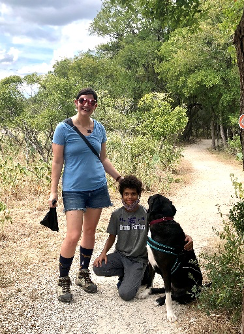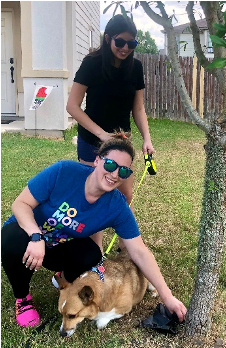 Yes, we’re talking about our dogs. And their poop. And being off leash. We’re lucky to have so many Natural Areas right here in our city, and to be able to have our dogs join us on our hikes. However, we hear constant complaints that too many dog owners are not cleaning up after their pup, or are letting their unleashed “Oh, but she’s friendly!” friend jump up on other hikers or growl menacingly as they approach. So, let’s brainstorm some ideas!
Yes, we’re talking about our dogs. And their poop. And being off leash. We’re lucky to have so many Natural Areas right here in our city, and to be able to have our dogs join us on our hikes. However, we hear constant complaints that too many dog owners are not cleaning up after their pup, or are letting their unleashed “Oh, but she’s friendly!” friend jump up on other hikers or growl menacingly as they approach. So, let’s brainstorm some ideas!
The first step in preventing problems is to educate ourselves. Rachel Sanborn, Director of Operations for the San Marcos River Foundation, notes the ways in which SMRF has reached out to the public about dog waste and its impact on the river. She says that when SMRF was invited to Pet Fest, they had cards printed with this information to share:
[gdlr_styled_box content_color=”#ffffff” width=”70%” background_color=”#54772F” corner_color=”#3d6817″ ]
FACTS ABOUT HARMFUL EFFECTS OF PET WASTE:
- Pet waste is 3rd biggest pollutant in urban watershed
- 20-30% of bacteria in urban river is traced to dog waste
- One gram of dog poop contains 23 million bacteria. A 1982 study in Maryland showed dog feces was the single most contributor of fecal strep bacteria and fecal coliform. Giardia and Salmonella can also be found in dog waste.
- The waste from a 40 lb dog in one day has more nitrogen than fertilizer companies recommend once or twice a year.
- The natural ecosystem can handle dog waste from two dogs per square mile. Urban arms average 125 dogs per square mile.
- Harmful bacteria in dog waste can last weeks.
- Pet waste washed into rivers decays, uses up oxygen and sometimes releases ammonia. Low oxygen and ammonia (especially in low water years) plus Texas heat can cause fish kills.
- Pet waste nutrients also encourage algae growth that also affect oxygen levels and they can also carry diseases which make river unsafe for recreation.
*** So with a population of over 58,000 people in SAN MARCOS:
- It is estimated we have over 8,000 dogs.
- One dog creates 150-274 lbs of waste a year.
- That works out to a ton of dog waste per day— more than 365 tons a year.
[/gdlr_styled_box]
 That information is certainly an eye-opener, especially the sheer amount of waste produced by dogs in our city. Fortunately, each trail user can do their part to Keep San Marcos Beautiful (and Healthy) by simply picking up after their pet and disposing of the bag in the trash can at the trailheads.
That information is certainly an eye-opener, especially the sheer amount of waste produced by dogs in our city. Fortunately, each trail user can do their part to Keep San Marcos Beautiful (and Healthy) by simply picking up after their pet and disposing of the bag in the trash can at the trailheads.
SOLUTIONS IN PLACE ELSEWHERE:
Since our Natural Areas are designed to move water back into creeks and through recharge zones into the aquifer, and since much of this water eventually ends up in our beautiful San Marcos River, this amount of poop left behind on our trails to “just wash away” or magically disappear is disturbing. It’s unhealthy to people, to our aquifer (drinking water), and to our river. Earlier this year, some SMGA members took a field trip to watersheds/natural areas managed by Austin’s Water Quality Protection Agency. The WQPA does NOT allow dogs on their trails and natural areas because they have seen the problems with dog waste in city parks. They make WATER QUALITY their #1 priority and recognize the seriousness of unmanaged dog waste pollutants in recharge areas.
WHAT ABOUT SAN MARCOS?
- SMGA and the City of San Marcos have posted signs at every trailhead with Dogs on Leash and Cleaning up After Your Pet ordinances and the consequences for violating them (fines of $500, or $2,000, if you want to classify dog waste as “public health and sanitation”).
- Free poop bags and trashcans are easily accessible to every dog owner. (People! If you’ve gone to the trouble of bagging it, you can carry it few more yards to the trashcan!)
- SMGA gives positive reinforcement with Facebook photos of responsible dog owners seen on trails. Dogs on leash, poop bag in hand!
- If you’re concerned about off-leash dogs, you can find or carry a big stick for protection. Sticks are useful on trails anyway. (To encourage people to leash their dogs, you might say that you just saw some Rangers on the trails behind you.)
- Carry a cell phone so that if an unleashed dog bothers or attacks you or your leashed dog, you can take photos. If you don’t feel comfortable taking photos (due, say, to an aggressive dog owner) then make identifying notes in your phone.
 AND MORE IDEAS FROM YOU!
AND MORE IDEAS FROM YOU!
We get it that we’re singing to the choir here. Members of the SMGA community do tend to understand the delicate balance of human interactions and nature and act deliberately to Leave No Trace. Have you been to a natural area or park that has had success with this problem? What did they do?
Do we want to raise and spend money to create graphic signs showing trail users how dog waste ends up in river?
Do we want the City to spend more time and energy enforcing the ordinances?
SMGA Outreach has discussed more interventions/interactions with apartments that back up to trailheads. What do you think?
Has anyone had success speaking to a dog owner about leashing or picking up after their dog? What did you say? Is there a catchphrase others could use?
Rachel mentioned that SMRF has discussed an incentive program rewarding those who follow the rules. Should we follow up on that?
 Author’s note: Fortunately, most dog owners are doing the right things! I enjoy talking to hikers about their dogs, and I am that person that asks if I can pet every dog I meet. I appreciate the fact that walking the trails gives both dog and dog owners much needed exercise and stress relief! Our Natural Areas have improved our quality of life in San Marcos, and they have become more renowned outside of our city. Thanks to you all who go out there and pick up pieces of trash, help lost visitors, and Leave No Trace. And responsible dog owners, we see you and appreciate you! If you have any ideas on how SMGA can address this issue, please reach out to us at [email protected].
Author’s note: Fortunately, most dog owners are doing the right things! I enjoy talking to hikers about their dogs, and I am that person that asks if I can pet every dog I meet. I appreciate the fact that walking the trails gives both dog and dog owners much needed exercise and stress relief! Our Natural Areas have improved our quality of life in San Marcos, and they have become more renowned outside of our city. Thanks to you all who go out there and pick up pieces of trash, help lost visitors, and Leave No Trace. And responsible dog owners, we see you and appreciate you! If you have any ideas on how SMGA can address this issue, please reach out to us at [email protected].
Thanks to the Perez family, and to Mandy and Gabe (and their best friends) for posing in the Texas heat.
Written by Monique Tschurr, with thanks to Rachel Sanborn for sharing information. Monique Tschurr is an educator, mountain bike enthusiast, and member of the SMGA Outreach Committee.
